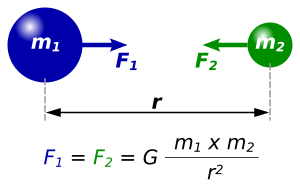
Back ثابت الجاذبية Arabic Constante de gravitación universal AST کوتله چکیمی ثابیتی AZB Гравітацыйная пастаянная Byelorussian Гравітацыйная канстанта BE-X-OLD Гравитационна константа Bulgarian মহাকর্ষ ধ্রুবক Bengali/Bangla Constant de la gravitació Catalan نەگۆڕی ڕاکێشان CKB Gravitační konstanta Czech

The gravitational constant, called in physics equations, is an empirical physical constant. It is used to show the force between two objects caused by gravity. The gravitational constant appears in Isaac Newton's universal law of gravitation.
is about 6.67430×10−11 N⋅m2/kg2,[1] and is denoted by letter . In the SI system, the constant is equal to the force in newtons that two objects, each with a mass of 1 kilogram, exert on each other at a distance of 1 meter.
It usually appears in Sir Isaac Newton's law of universal gravitation, and in Albert Einstein's general theory of relativity. It is also known as the universal gravitational constant, Newton's constant, and colloquially as Big G.[2] It should not be confused with "small g" (g), which is the local gravitational field of the Earth (equivalent to the free-fall acceleration).[3]
- ↑ "2018 CODATA Value: Newtonian constant of gravitation". The NIST Reference on Constants, Units, and Uncertainty. NIST. 20 May 2019. Retrieved 2019-05-20.
- ↑ Gundlach, Jens H.; Merkowitz, Stephen M. (2002-12-23). "University of Washington Big G Measurement". Astrophysics Science Division. Goddard Space Flight Center.
Since Cavendish first measured Newton's Gravitational constant 200 years ago, "Big G" remains one of the most elusive constants in physics.
- ↑ Halliday, David; Walker, Jearl; Resnick, Robert (2007). WIE ASE Fundamentals of Physics Extended, Eighth Edition, Asian Student Edition. p. 336. ISBN 978-0-470-04618-0.
